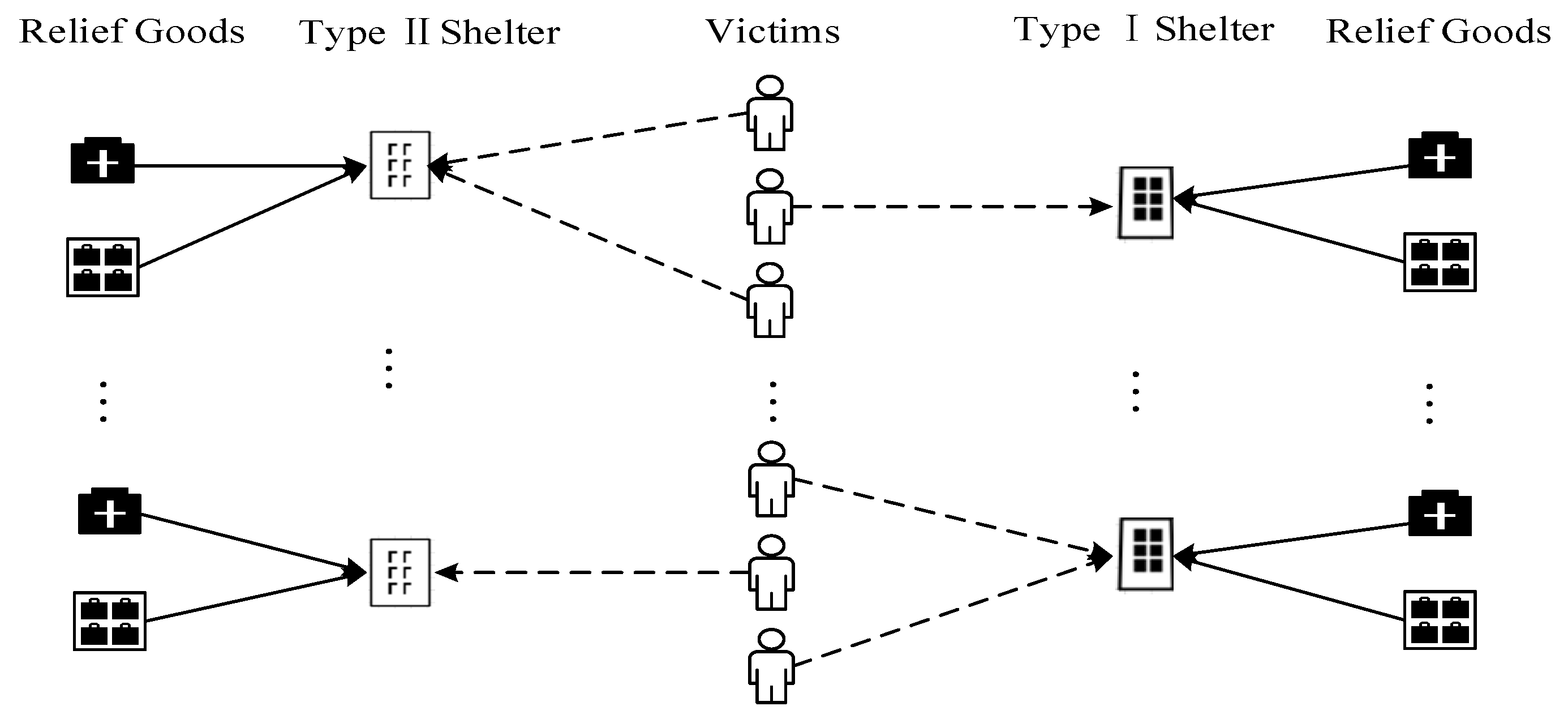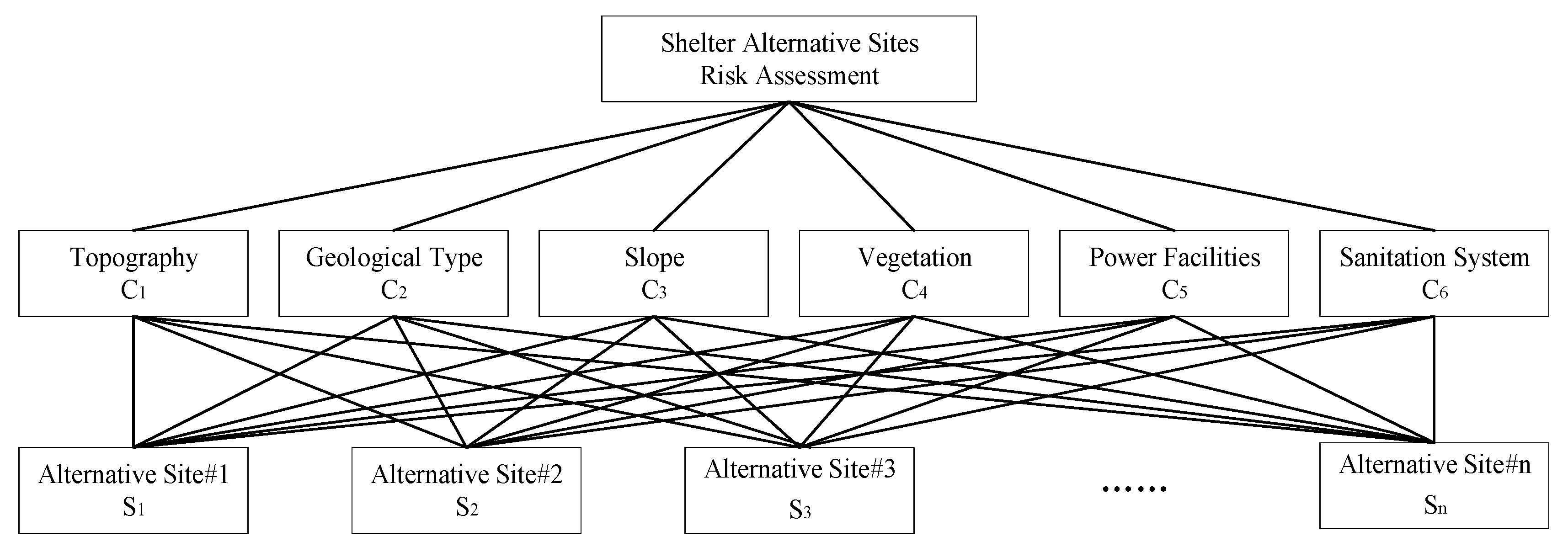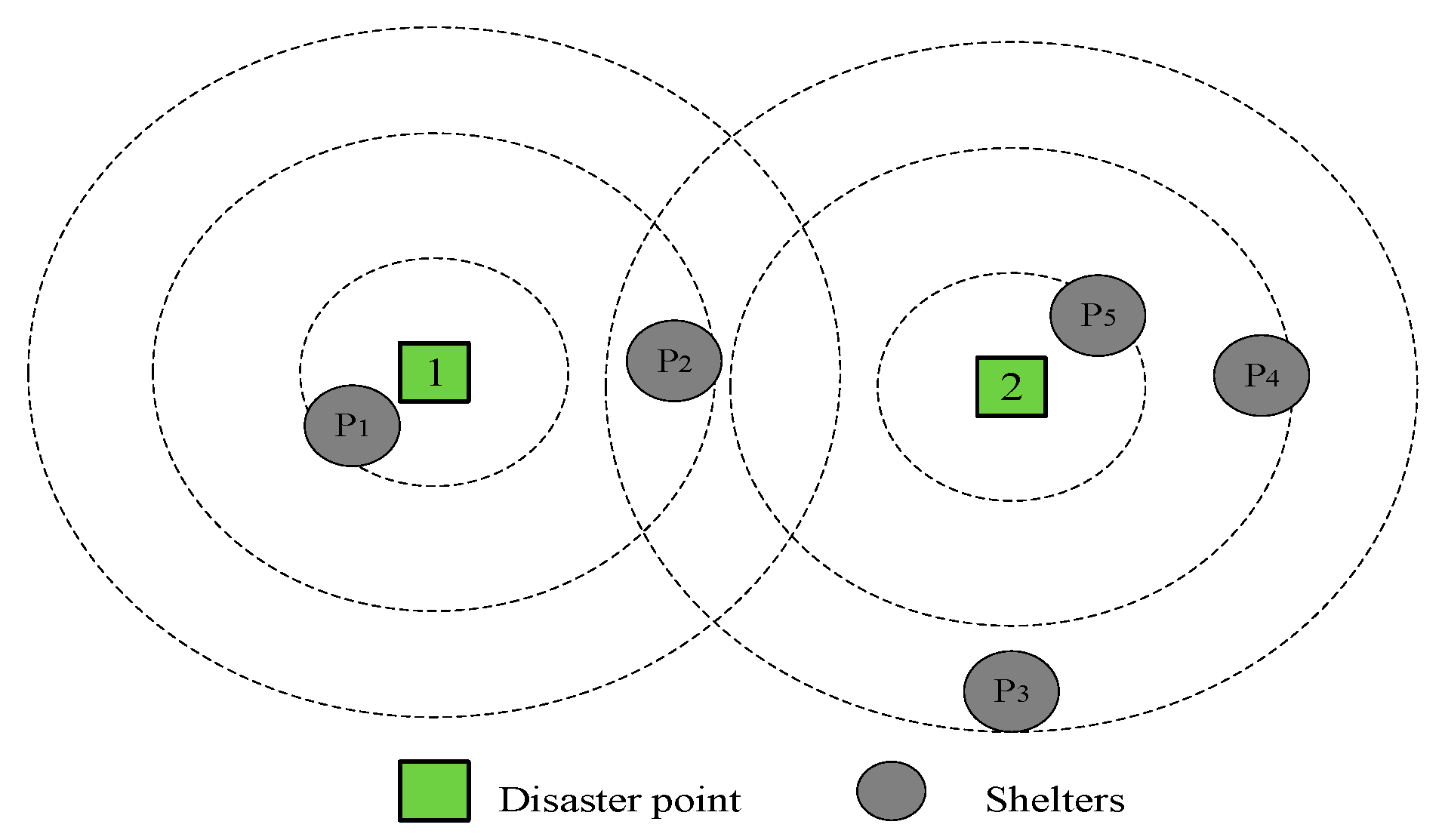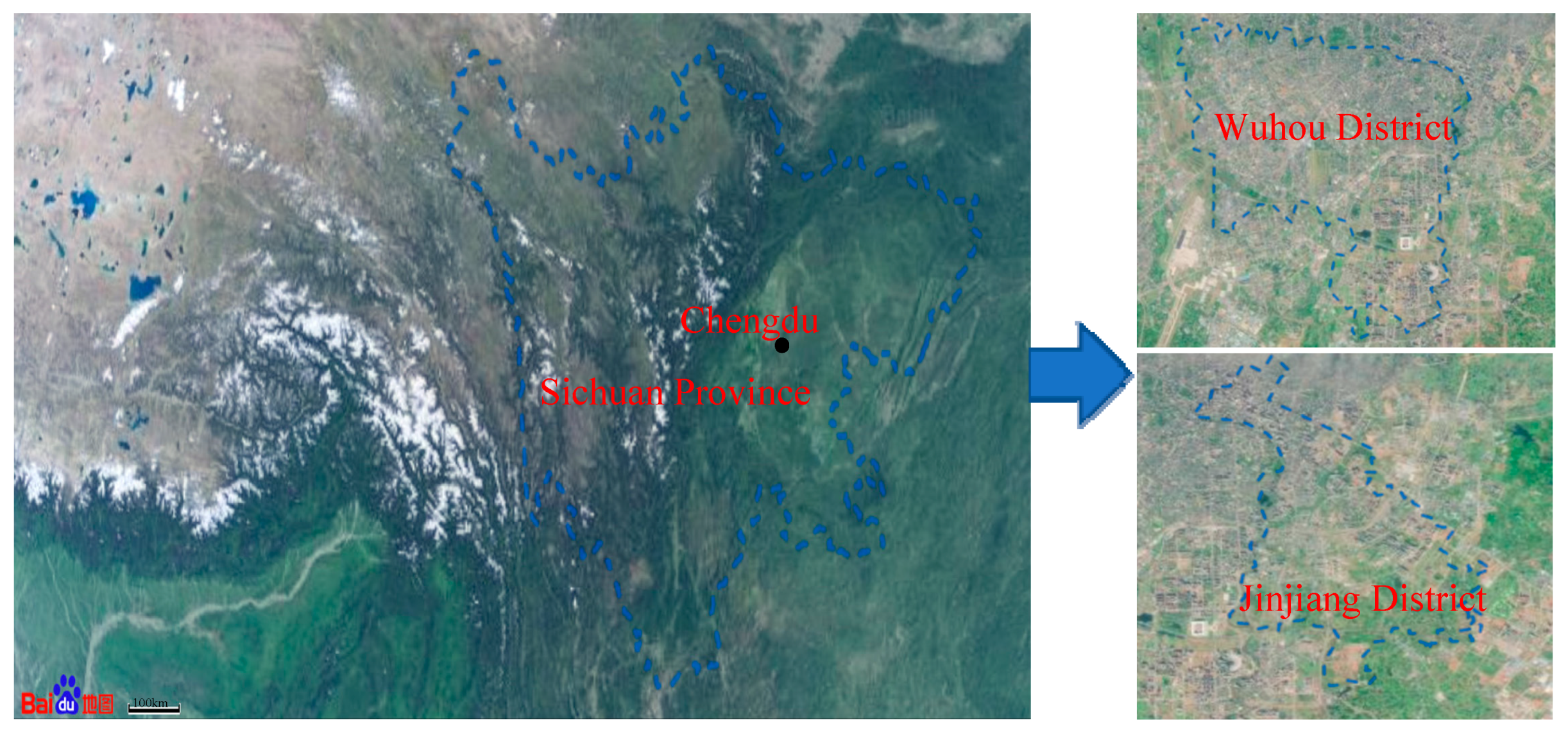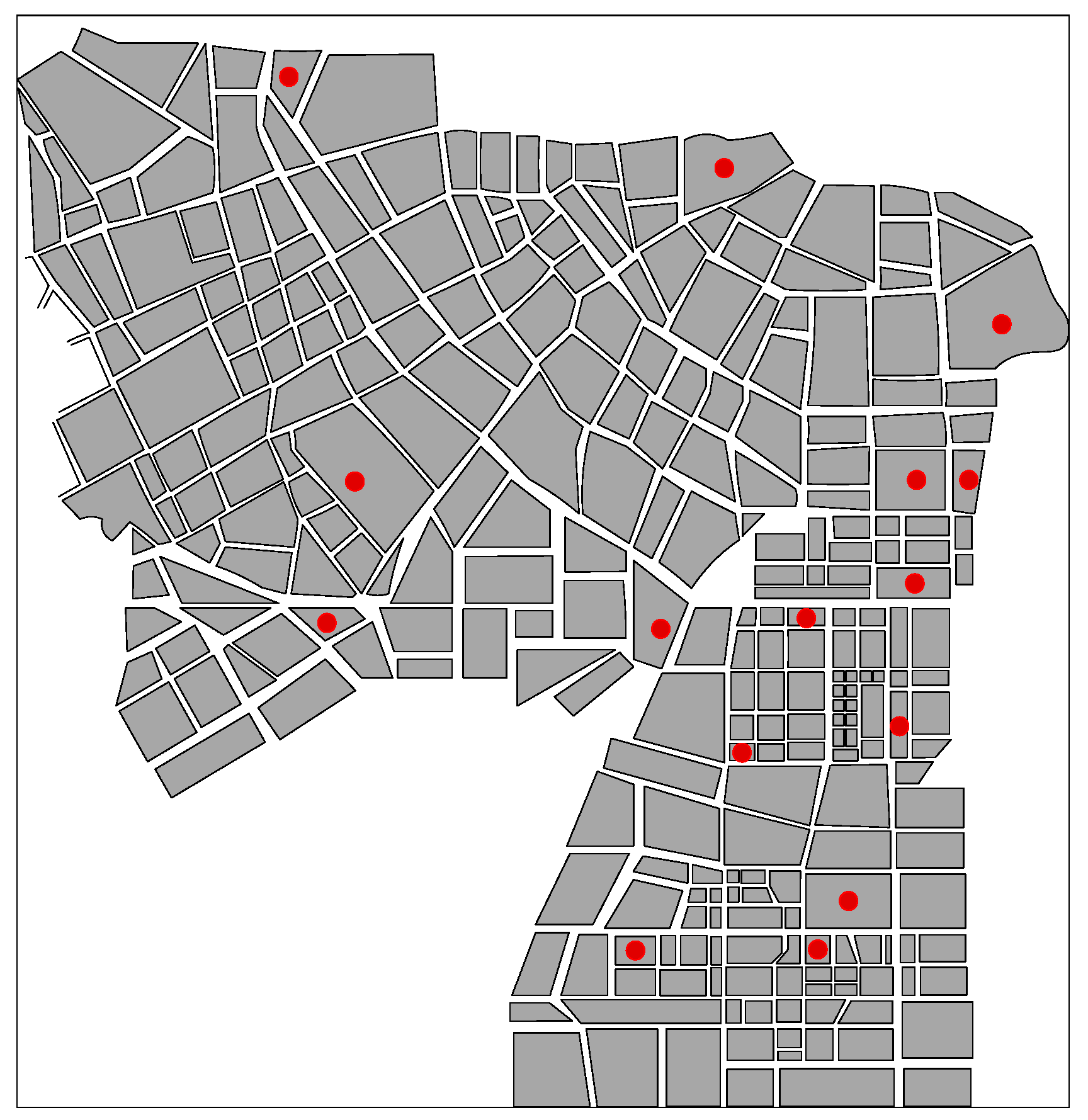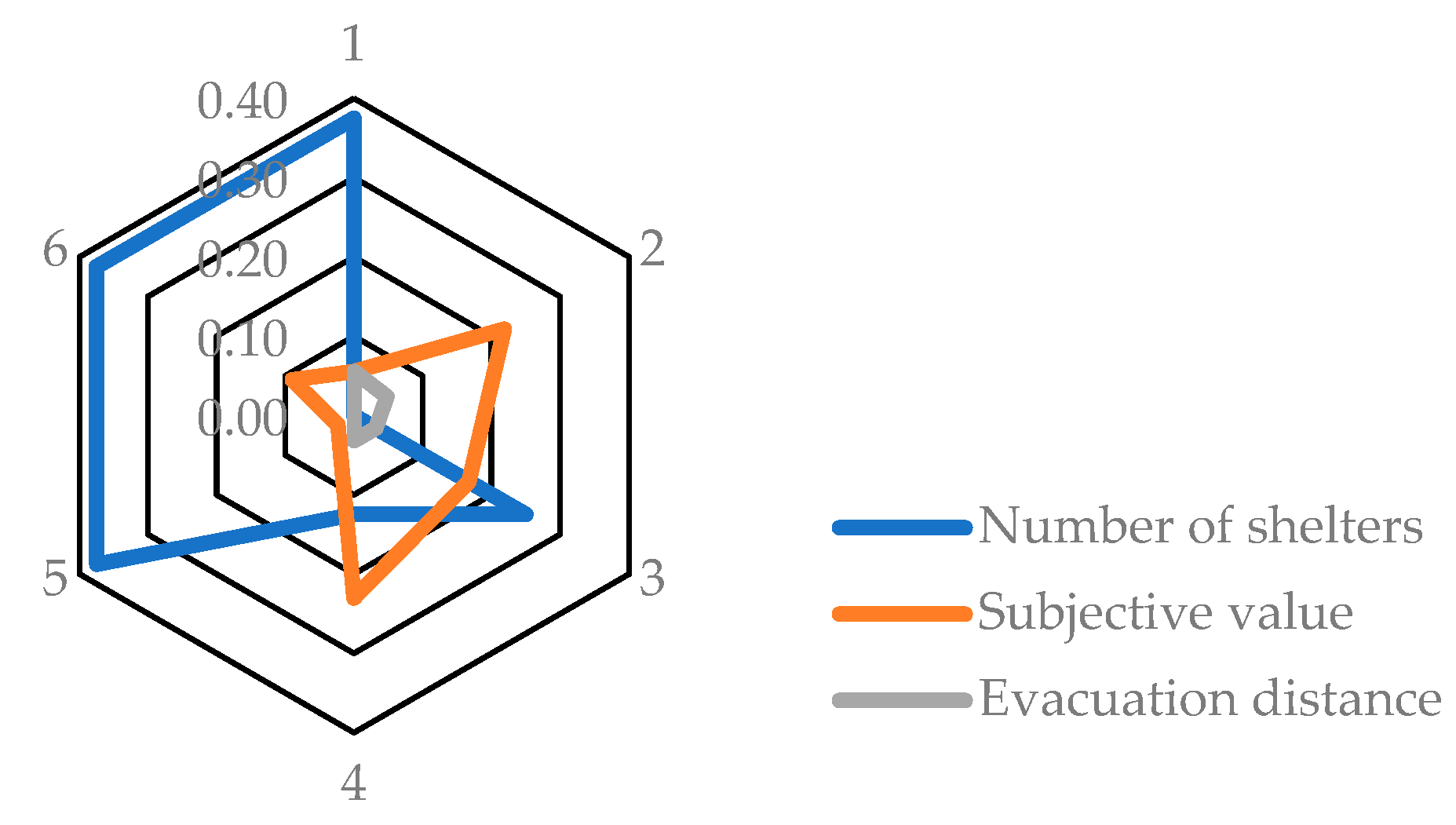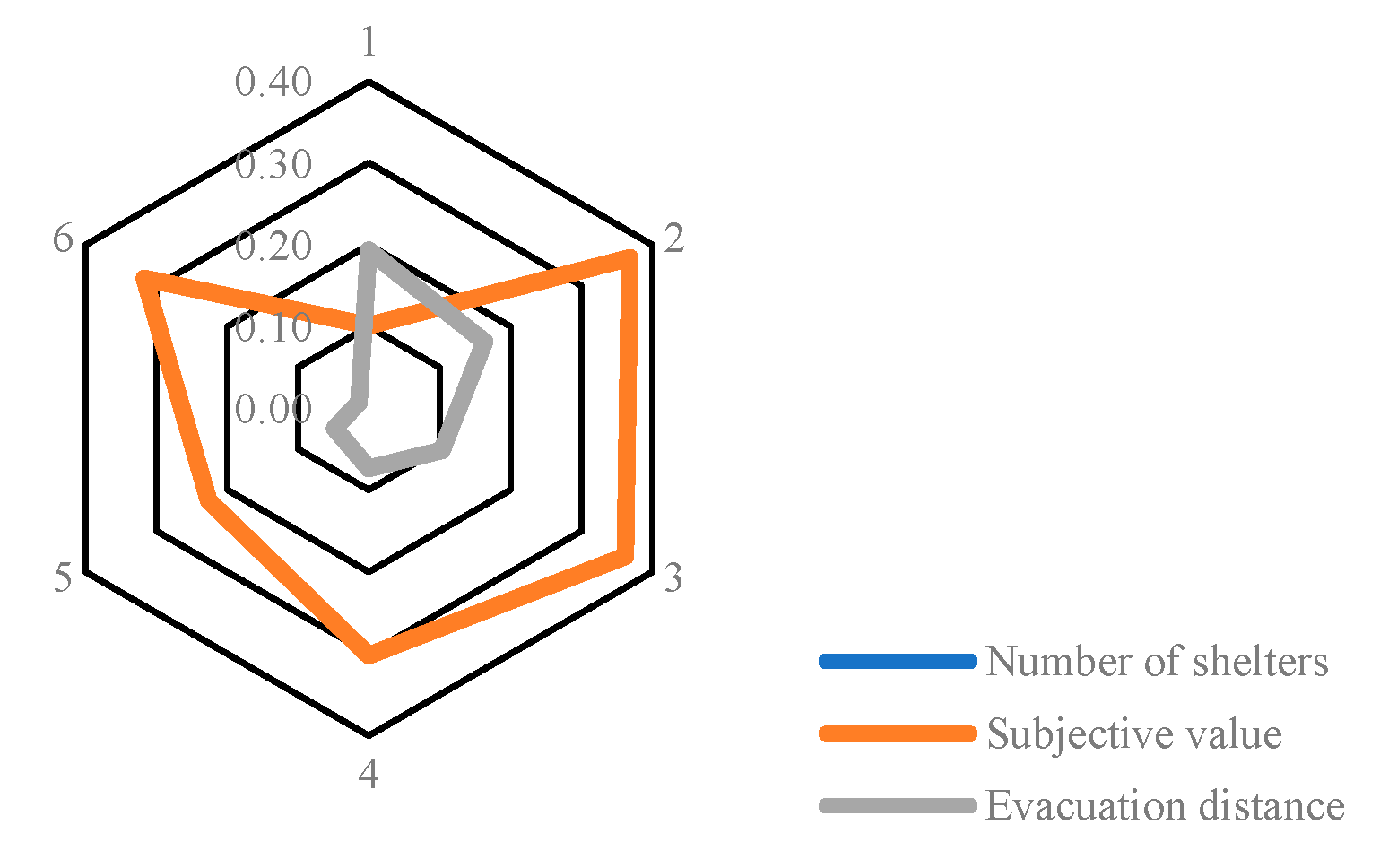Using the relative weights of candidate points as model input parameters, MATLAB2018b is employed to solve a mixed integer multi-objective optimization model on a PC with a 3.60-GHz Intel Core i7-4790 CPU and 8 GB of RAM, running Windows® 10 OS.
5.1. Results for the Case Study
In the case study of Wuhou District, the model is run by considering each target individually to determine the optimal value for the target. In addition, when a single target is given the same weight, the results of the evacuation site selection are shown in
Table 6.
Table 6 shows that two of the 15 candidate points (S5 and S9) are selected as Type I shelters, and seven are chosen as Type II shelters. The third line refers to the number of victims who need service 1 to be allocated to open shelters (Allocation 1). Similarly, the fourth line shows the number of victims who need service 2 to be allocated to open shelters (Allocation 2). S5 and S9 are only Type I shelters, so assigning victims who need mental health services to these locations is impossible. The last two lines indicate the amounts of living and medical materials stored in indoor shelters or surrounding facilities.
The difference between the achieved target and the single target optimal value is presented in
Table 7. Given that the Objective (19) function value for optimizing the evacuation distance is in the order of magnitude, the original value is rounded down to log base e. It can be seen from
Table 7 that the evacuation distance obtained from the optimization solution is 25.95 instead of 25.15. The evacuation distance optimization result is the best among the three target values, which is slightly different from the ideal value. The optimal number of refuge centers is nine, one more than the minimum number of shelters. The result of the subjective weight optimization finally deviates greatly from the optimal target value. When the subjective weight is as important as the other two target values, it is difficult to achieve better results. Considering that the parameter
in the model may affect the optimization result, different values are used to reflect the influence on the solution. The results of the optimization under the other five different weights are shown in
Table 8.
The radar chart in
Figure 7 illustrates the effect of changes in target weights on target deviation. Radar charts indicate that the total objective function is sensitive to changes in subjective weights. The process of shelter selection and the importance of qualitative factors are considered. The combination of qualitative and quantitative factors makes the site selection decision reasonable. This illustrates the importance of combining qualitative dimensions with quantifiable factors, while locations with poor service quality are unlikely to be selected as open shelters. The optimization results are also sensitive to changes in the number of shelters. It can be seen that the model is very sensitive to the site of the shelter while considering the number of open shelters. When the number of shelters is taken seriously, deviations can even be eliminated. The rational planning of the number of shelters has an important impact on site selection results, and the results are least sensitive to changes in shelter distances.
It can also be seen from
Table 8 that when the deviation of the number of shelters decreases, the deviations of the evacuation distance and subjective weight increase. However, when the deviation of the number of shelters increases, deviation of the remaining two objective function values can be reduced. Therefore, increasing the number of open shelters is beneficial for optimizing the distance and quality of shelters.
To further evaluate the impact of rescue budget and coverage ratio on rescue effectiveness, we set the budget amount to vary from 7,500,000 to 8,500,000, different coverage distances (
) and coverage ratios (
):
;
;
;
. The experimental results are shown in
Table 9,
Table 10,
Table 11 and
Table 12 below.
By comparing the results in
Table 9,
Table 10,
Table 11 and
Table 12, we can conclude that when the budget amount increases, the deviation of the subjective weights slightly decreases. This condition may signify that additional funds can be used to open other shelters with improved subjective evaluation performance, thereby increasing the overall quality of service. Similarly, the distance between victims and shelters is close to the optimal value in the case of single goals. Although there is a large deviation between the number of open shelters and the case of single-objective optimization, the increase in rescue budget is an effective method to improve the rescue effect when the number of alternative shelters is sufficient.
Table 9 and
Table 10 present that changing the coverage rate of different distance levels of the shelters can increase the subjective weight of the shelters, although the deviation of the shelters increases. In this way, life and psychological medical services are well provided to the victims. The same distance and reduced coverage ratio have a great impact on the evacuation distance. In the case of multi-objective optimization, the evacuation distance is even without deviation from the single-objective solution. The same conclusion can also be drawn from
Table 11 and
Table 12.
Observing
Table 9 and
Table 11, we can find that the distance between victims and shelters is further restricted when coverage ratios are constant. With the limited rescue budget, the effect is not obvious, and the evacuation distance deviation has increased. When funds are sufficient, the deviation of the distance to the shelters are significantly improved. The reason is that excess funds are available to open additional shelter facilities, which is reflected in the increased deviation of the number of open shelters. By reducing the distance covered by shelters, the overall quality of shelter services has also improved. Similar observations can also be made by
Table 10 and
Table 12. Setting stricter shelter coverage is beneficial to improve rescue results.
In the Jinjiang District case study, the model is calculated by assigning the same priority to the three targets to obtain a compromised result. The results of the most preferred sites and allocations are shown in
Table 13. One of the nine candidate points (S7) is selected as a Type I shelter, and four are chosen as Type II shelters.
Table 14 shows the optimal values of achieved and single goals. The deviation of the evacuation distance target value is small, and the number of open shelters is optimal. The largest deviation is the distance from the victims to shelters. The deviation of different target weights in
Table 8 is illustrated in
Figure 8.
Similarly, to clarify once again the impact of rescue budget and shelter coverage ratio on the overall rescue effect, the budget amount is set to vary from 4,500,000 to 5,500,000, and different coverage distances (
) and coverage ratios (
):
;
;
;
. The experimental results are shown in
Table 15,
Table 16,
Table 17 and
Table 18 below.
5.2. Guidelines for Using Optimization Models
In real life, victims often randomly choose an evacuation site nearby after a disaster. However, these unplanned locations cannot immediately meet their needs. Authorities have difficulty using the scarce rescue resources to provide emergency relief, and in the long run, they cannot conveniently live for a while. No plan was implemented for the migration of affected people after the Wenchuan earthquake. Most shelters were spontaneously selected without considering the different needs of victims. Therefore, since 2008, planning and construction of emergency shelters has received increasing attention throughout the country. By solving the results of these two cases, the effectiveness and importance of the model in selecting opened shelters, allocating victims, and relocating supplies are emphasized.
The proposed multi-criteria decision-making model considers all the important influencing factors necessary for people’s lives and medical processes after the disaster. The model also aims to be a planning tool for improving the decision-making ability of disaster managers in location and allocation. Existing high subjective evaluation warehouses are included in the candidate points set, and an attempt is made to find a suitable facility location in the requisition and use of emergency humanitarian logistics [
28,
47].
The model has optimized three different goals at the same time. The first goal attempts to take into account the victims’ relocation to the nearest shelter. The model also ensures that victims are placed in the most appropriate shelters selected based on qualitative criteria. The final goal is to keep the number of open shelters to a minimum for better management in costs and logistics. The model performs single-objective optimization to propose specific target values for different targets, and reduces deviations to finally determine an effective solution. Therefore, it may be beneficial to address the evacuation of people and the attention to victims at shelters.
In different disaster-prone areas, the relative importance of different targets can change. In some cases, convenient logistics is the most important factor, while in other cases, evacuation nearby is more popular than others. Therefore, the constructed model can satisfy decision makers to set weights for each objective function and specify preferences to determine the best evacuation location and personnel and material allocation plan. By performing a sensitivity analysis on the model, the available rescue budget and coverage of different refuge levels are identified as key parameters. By observing the effect of parameter value changes on the optimization results of the objective function, determining and selecting “important” shelters are suggested. Therefore, the proposed evacuation site selection model is helpful for reasonable planning and immediate rescue after disasters.

